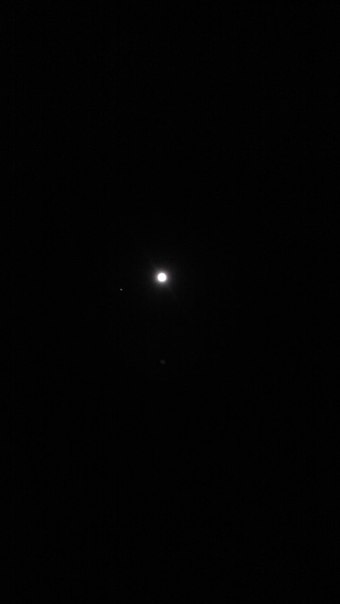Jupiter lords over the March nighttime sky.
And tonight it converges with the Moon. Here the first picture of this awesome sky phenomenon.

Jupiter is the only planet to light up the sky almost immediately after sunset, blazing away in the east at nightfall or early evening in early March.

Jupiter reached opposition on March 8, at which time this brilliant world rises in the east at sunset, climbs highest up for the night at midnight and sets in the west at sunrise. Jupiter’s opposition is an especially celebrated event, because that’s when this world is out all night long, from dusk till dawn. Moreover, this is when Earth comes closest to Jupiter for the year, and Jupiter, in turn, shines at its brightest best in Earth’s sky.

Jupiter’s opposition happened less than one day before the new moon, providing a deliciously dark sky for observing Jupiter through the telescope. By the way, the new moon on March 8-9 passed in front of the sun, to stage a total solar eclipse in Indonesia, and a partial solar eclipse for much of southern and eastern Asia, northern and western Australia, Alaska and Hawaii.

The moon swings close to Jupiter on the sky’s dome for several days, centered on March 21.

If you have binoculars or a telescope, it’s fairly easy to see Jupiter’s four major moons, which look like pinpricks of light on or near the same plane.

They are often called the Galilean moons to honor Galileo, who discovered these great Jovian moons in 1610. In their order from Jupiter, these moons are Io, Europa, Ganymede and Callisto.

These moons circle Jupiter around the Jovian equator. In cycles of six years, we view Jupiter’s equator edge-on.

Although Jupiter’s axial tilt is only 3o out of perpendicular relative to the ecliptic (Earth’s orbital plane), Jupiter’s axis will tilt enough toward the sun and Earth so that the farthest of these four moons, Callisto, will NOT pass in front of Jupiter or behind Jupiter for a period of about three years, starting in late 2016.

During this approximate 3-year period, Callisto will remain “perpetually” visible, alternately swinging “above” and “below” Jupiter.

All of this is awesome. Keep your eyes to the skies.












